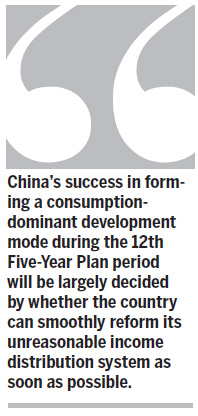Common prosperity the focus
Updated: 2011-02-22 07:57
By Chi Fulin (China Daily)
|
|||||||||||

New development model is based on consumption, a greener economy and a balanced national public service network
An essential requirement for the transformation of China's economic development mode lies in its adoption of policies and reforms that put top priority on increasing people's incomes instead of the State coffers.
The 12th Five-Year Plan period (2011-2015) will be a crucial period for the country to promote such a policy change and establish a new development model based on consumption, urbanization, a low-carbon economy and the development of a balanced public services network.
To this end, the country should try to realize its transformation from an investment-obsessed mode of development to consumption-dominant one as soon as possible.
International experience indicates that a decline in investment and exports is irreversible when a country comes to the development stage of $3,000 and $4,000 in terms of its per capita gross domestic product.
Raising the consumption capacity of China's huge number of medium and low-income residents and creating good consumption expectations are essential in order to boost not only domestic demand, but also to facilitate people's prosperity and equitable social development.
The transformation to new consumption-dependent growth model during the next five years will become an intrinsic driving force for China's medium and long-term equitable and sustainable development.
From a domestic perspective, the country's consumption structure is upgrading and the proportion of its development expenditures has been on the rise in urban areas and there is huge consumption potential in its vast rural areas.
However, China's success in forming a consumption-dominant development mode during the 12th Five-Year Plan period will be largely decided by whether the country can smoothly reform its unreasonable income distribution system as soon as possible. Practicable measures to raise the level of people's real incomes, narrow the income gap, ensure an orderly and equitable income distribution mechanism, and to develop an open and transparent financial system will greatly boost the contribution of domestic consumption to the country's economic growth.
The country's rich-poor gap largely lies in the income gap between urban and rural areas. If China's urbanization ratio could be raised from the current 46.6 percent to over 50 percent at the end of the 12th Five-Year Plan period, its domestic consumption would be greatly boosted and a big step would have been taken toward promoting widespread prosperity among the people. To this end, practicable measures should be taken to promote an industrialization-led urbanization-focused transformation over the next five years, especially by promoting the development of small and medium-sized cities and the urban-rural integration.
A low-carbon economy is also needed to promote the transformation of the country's economic development mode and people's prosperity. As a developing country in transition, developing a low-carbon economy is not just a challenge, it also provides a rare opportunity for China. The establishment of a low-carbon model will promote not only energy conservation and emissions reduction, but also technological innovations. It will also catalyze a sweeping environmental revolution throughout society and bring profound changes to people's lifestyles. To expedite such a transformation, the country should link its economic development speed to its energy consumption in the years ahead in a bid to promote economic growth under specific and regulated energy consumption targets. To create a low-carbon economy, China should accelerate reforms of the price formation mechanism in the fields of resources and energy as well as reforms of its environmental property rights system. It should also step up building a carbon trade regime.
To build a prosperous society for all of its 1.3 billion people, China should also accelerate the development of a balanced public service network between urban and rural areas to meet the ever-growing demands of society for public products and services. This is one of the keys to realizing prosperity-prioritized development in China, and would serve as a significant move to boost the country's domestic demand. Currently, China's nominal income gap between urban and rural areas is 3.3:1, and, if disparities between education, healthcare, social security and other public services are added, it widens to 6:1. Unequal public services contribute 40 percent to the country's urban and rural income gap.
Given that there are both economic and institutional factors behind the current imbalance in public services between urban and rural areas, China should accelerate the adjustment of its financial spending structure and public finance and the responsibilities of the central and local governments should be explicitly defined so as to develop a balanced public services network nationwide.
The author is director of Hainan-based China Institute for Reform and Development.
(China Daily 02/22/2011 page8)




